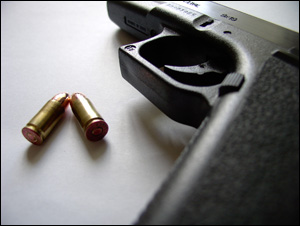 Nothing is more important for a responsible gun owner than to teach his or her children about firearm safety. With over 200 million firearms currently in the country, and half of these being stored at home, the opportunity for abuse and accidents should never be underestimated.
Nothing is more important for a responsible gun owner than to teach his or her children about firearm safety. With over 200 million firearms currently in the country, and half of these being stored at home, the opportunity for abuse and accidents should never be underestimated.
So how does one teach a child about how to be safe around guns? There are several levels of firearms instruction, depending on the age of the child.
For Young Children
Children often have the wrong, almost idealistic perception of firearms. For example, children should be made to understand that firearms depicted in the movies are stage props that really don’t injure people, and that real firearms are very dangerous and can hurt and kill people. In real life, they must be handled with extreme caution even by adults. The overriding rule here is: Never touch a firearm unless a parent or adult guardian is sitting right next to you and is watching you.
Of course, young children should never have independent access to a gun. They simply don’t understand the permanence of poor decisions. Even if a child is taught not to touch a gun without supervision, if he or she is able to access one, at some point, curiosity will override good sense. Keep your guns locked up.
Older Children and Teens
Many teens and older children know about firearms and may even be fascinated by them. Some teens may have actually discharged them at a friends’ or neighbors’ houses without adult supervision. Teens should be allowed to handle unloaded firearms but only under close adult supervision.
At this age, they can be properly instructed on how to inspect a firearm to see if the chamber or the magazine is empty. They should be taught never to point a firearm at any person and never to place their finger on the trigger unless they expect the firearm to “fire.” Supervised access is important so that kids can learn proper handling and cement these rules in their habits.
Gun Club and Firing Range
You should also take teens and older children to a gun club or firing range. Make sure they have proper eye and ear protection. It’s best to start off with a small-bore rifle – like a 22 caliber. Shooting a pistol should come later for older teens. Have them watch you as you properly load the firearm and point it downrange. Make sure they understand the proper stance and method of holding a firearm (called “snapping in” by Marines).
Take your time and be sure your kids do to. Awareness when handling a loaded firearm is a practiced skill, and they should understand the “why” behind every step.
“Snapping in,” Firing and Muzzle Control
Load the firearm with one round and let them fire it. Re-emphasize muzzle control at this point. Once fired, children and teens (especially if it’s their first time) will be so excited they’ll swing the barrel up toward you. This has caused some firearms to “go off” accidentally – so remember, load one round at a time. If they’ve never fired a firearm, warn them of the “kick” a firearm will deliver to their shoulder. Children and young, lightweight teens should be made to brace themselves for a firearm’s recoil. It’s common for adults to find humor in the surprise that a first big recoil can cause, but a lot of real injuries happen that way, and injecting humor (and humiliation) into a lesson about gun safety isn’t wise.
Explain to them that this is often not shown on TV or in the movies, since prop guns typically use “stage load” ammo that has virtually no kick when discharged. (This is why you’ll see 100-pound models in movies shooting AK-47s on full auto with no recoil.)
The Hunt for Live Game
At this stage, you can take older children and teens hunting for small game – waterfowl, turkeys, squirrels or doves. The first few times, kids should be there simply to observe not just the routine and custom of hunting, but to realize the lethality of firearms. If your child enjoyed the experience and wants to come back, that’s when you can begin teaching the finer points of hunting. However, it’s never a good idea to insist on having them participate if they really don’t like it.
Regardless of how you and your family use or relate to guns, kids need to know about them and understand them. Never assume they will learn what they need to, unless you teach it to them.
About the author: Adam Enright works at the gun safe store, where he teaches about gun safety and how to handle guns properly.
Photo Credit: guidonz